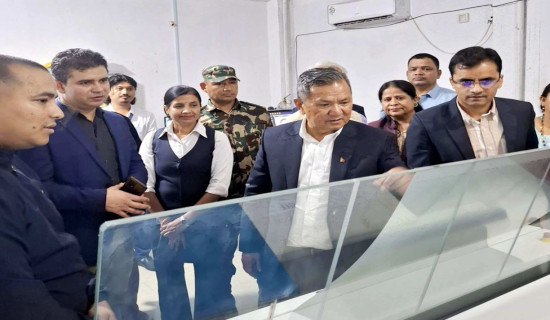- Tuesday, 13 May 2025
Roots Of Ramen
Aashish Mishra
Ramen, sometimes spelt Ramyeon, has skyrocketed in popularity in Nepal over the past few years, so much so that we not only have the typical Ramen noodles but also Ramen corn puffs, crisps and crackers. There is no department store or grocery shop that does not keep Ramen and restaurants have also begun serving Ramen dishes. So, it may be worth exploring where this food that has so enamoured the Nepali tongue came from. It may be appropriate to look at the roots of Ramen.
According to Rapedia, a Japanese website that keeps information on all things Ramen, Ramen is a Japanese adaptation of traditional Chinese noodles that originated in the 19th century. Food historians believe that the dish came to Japan with Chinese immigrants and the Yokohama Chinatown located south of Tokyo is where it first spread from. But Ramen really boomed in Japan after the opening of the first Ramen shop in Asakusa.
Early versions of the noodles came with various toppings and included pork or dumplings as side dishes. But as it grew in popularity, the side dishes vanished and Ramen became a stand-alone favourite people had for lunch or as street food.
Nevertheless, Japan was still a rice-eating country. Ramen was popular, yes, but it was popular in the same way momo is popular in Nepal now – as something cheap to munch on during the day or with friends but not a viable meal. However, that changed after Japan’s defeat in World War II.
With its Asian empire gone, Japan lost much of the land and labour it had been exploiting to grow wheat. As a result, the country began experiencing food shortages. To prevent mass starvation, the American military, which was the occupying force in the East Asian nation after the end of the war, flooded Japanese markets with cheap wheat flour. This was intended to boost bread production but some traders also used it to make Ramen noodles.
Bread was not native Japanese food and rice was in short supply. So, many Japanese turned to Ramen for their nutritional needs. And, as the Japanese economy boomed and employment grew, many began viewing Ramen as a quick and easy alternative to cooking at home. People worked long hours and did not have the time or energy to spend in the kitchen. This helped associate the noodles with a busy urban life, which was a good thing in Japan in the mid and late-20th century. If you ate Ramen, it meant you had a good job and lived in affluence (you had the money to purchase food that was more expensive than rice). This drove up production and consumption exponentially.
By the 1980s, Ramen had become a Japanese cultural icon, featuring in movies, shows and songs and becoming an integral part of life. Japan also exported it to other countries and Japanese expats took it with them wherever they went. This helped spread it to other countries. The quick and easy Ramen became quicker and easier in 1958 after Taiwanese-Japanese Momofuku Ando invented instant noodles. Now, anyone could make Ramen by simply adding boiled water.
Interestingly, it was only after Ramen gained prominence in Japan that its motherland China began paying attention to it again. And China’s adoption of Ramen paved the way for it to enter Nepal.
At first, it came in the form of instant noodles – or Chow Chow, as we call it. Rara was the first Nepali manufacturer of the item that could be eaten cooked or straight out of the packet. Then the Thai brand Waiwai entered the Nepali market in 1984 and that changed everything. Nepal fell in love with Chow Chow and that eventually, to Ramen today.
To the untrained eye, all Ramen may look and taste the same. But there are quite a few varieties available in the market and chief among them is Miso Ramen. Invented in Sapparo, Japan, this Ramen has noodles topped with sweetcorn, bean sprouts, meat or garlic. Some may also add salt or soy sauce depending on their taste. Then we have the Kitakata Ramen which has thick curly noodles. Tokyo Ramen noodles are also curly but they are thin and are topped with eggs.
Yokohama Ramen is straight and is served in soy broth containing pork, mutton or chicken. When eaten at restaurants, customers can ask for the ingredients of the broth to be altered to suit their tastes.
Wakayama Ramen is special because its broth is made not with meat but with bones - pig, goat, chicken, buffalo, whatever tastes best to the consumer.

















